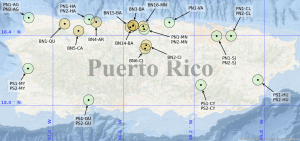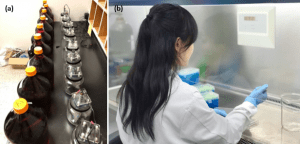In a recent study evaluating the degradation of drinking water quality after Hurricanes Maria & Irma, PROTECT researchers found that strong winds and flooding caused increased levels of metals and organic micropollutants contamination in drinking water. Drinking water quality degradation in municipal and private well water systems arises due to impaired regional water cycles and/or damaged water treatment systems. Damage to the water treatment systems in Puerto Rico was caused by strong winds and flooding as a result of these Hurricanes, which can potentially cause long-term adverse health consequences within affected communities. Former PROTECT trainee Yishan Lin explains, “Clean drinking water is critical to waterborne disease control and public health protection, yet is vulnerable to extreme environmental events such as hurricanes. Environmental pollution in Puerto Rico was extensive even prior to the 2017 Hurricanes, with over 200 hazardous waste sites including 18 active Superfund sites primarily contaminated by pesticides, chlorinated volatile organic compounds (CVOCs), and heavy metals. A various mixture of toxic substances can be released into waters sources due to flooding which may inadvertently be introduced into drinking water supplies.”

Figure 1. Map distribution of tap water sampling locations in Puerto Rico (PR). Eight sampling locations are not shown because of the absence of GPS information.
This study looks at the hurricane impacts on Puerto Rico’s drinking water quality, by using wide-spectrum chemical analysis (18 trace elements and 200 organic micropollutants) and state-of-the-art toxicity assays to test chemical contaminants and water toxicity changes at multiple time points following the storms. Tap water samples were collected from participants’ households across the region from December 2017 to February 2018 and compared with samples prior to Hurricane Maria. Overall, drinking water in Puerto Rico showed different contamination levels before and after Hurricane Maria with clear spatial patterns for both trace elements and organic micropollutants. Average concentrations of 14 out of 18 detected trace elements and 20 out of 27 organic micropollutants showed elevation; among which, arsenic, sucralose (sweetener), perfluorooctanoic acid (PFOA, perfluorochemical), atrazine-2-hydroxy (herbicide degradation product), benzotriazole (ultraviolet stabilizer), acesulfame (sweetener), and prometon (herbicide) were at significantly higher levels in the post-Hurricane Maria than in the pre-Hurricane Maria tap water samples. In addition, thirteen micropollutants, including four pesticides, were only detected in post-hurricane samples. Advanced statistical data analysis suggested that metals (i.e. arsenic) and PFOA were the top-ranked pollutants that have the potential to cause increased risk after Hurricane Maria.

Figure 2. (a) Tap water samples and organic extraction devices; (b) Toxicity testing in a UV-sterilized laminar-flow hood.
“This study is important because it provides the first comprehensive evaluation of a hurricane’s impact on drinking water quality and associated toxicity effects in Puerto Rico,” explains Yishan. “This research has the potential to expand understanding of contamination concerns from extreme weather events, as well as changes in the remediation and public education that follow these events. With a better understanding of potential adverse effects and risk-associated bioactive chemicals, it would be possible to guide post-disaster water resource management strategy and help minimize exposure to people and surrounding ecosystems.”
This study provides further insight to support PROTECT’s continued research in Puerto Rico which seeks to understand the mechanisms by which exposure to mixtures of suspect chemicals contribute to adverse pregnancy outcomes on the island. PROTECT will continue to investigate the impacts of extreme weather events on contaminant transport and exposure, and will develop new water treatment technologies for portable and robust water treatment systems.

Figure 3. A workflow of effect-directed drinking water quality analysis before and after Hurricane Maria in Puerto Rico.
